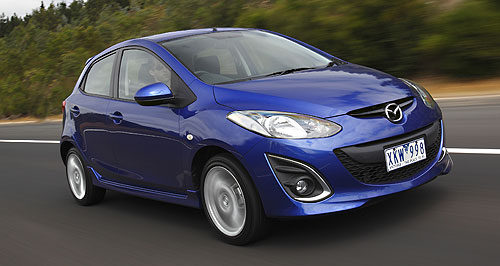Make / Model Search
News - MazdaMazda: Chinese cars no threat – yetPremium machine: Mazda says its Mazda2 is above the light-car zone attracting the Chinese car-makers. Imminent Chinese vehicle arrivals won’t affect Japanese brands, says Mazda7 May 2010 MAZDA says it will not be impacted by the imminent influx of cut-price small cars from China to Australia. At least four Chinese brands have committed to releasing entry-level light-sized hatchback or sedan models this year, but Mazda says its sales will not be affected because it does not operate at the bargain-basement end of the market. “Any competitor coming into the marketplace obviously is something we have to be concerned about,” said Mazda Australia managing director Doug Dickson. “But there are spaces in which we play and we don’t aim the Mazda2 at the basic entry-level market at all.” Chery is expected to release the first Chinese-branded passenger car in Australia in July, but the list of Chinese brands that have committed to releasing light-sized cars locally in the near future also includes Great Wall, Geely and Lifan. The fledgling Chinese brands are likely to put further pricing pressure on light-cars at the bottom end of the Australian market, which is dominated by Hyundai’s Korean-built Getz, the three-door version of which is officially priced from $13,990 plus on-road costs. The Getz will soon be joined by Hyundai’s new Indian-built i20 light hatch, while Suzuki made headlines by releasing Australia’s first Indian-built passenger car last year, the smaller five-door Alto hatch (priced from $11,790).  Left: Mazda Australia managing director Doug Dickson. Left: Mazda Australia managing director Doug Dickson.It was joined this year by Proton’s Malaysian-built S16 light sedan priced from $11,990, but Toyota’s once-dominant, Japanese-built Yaris (from $15,240 as a three-door) still holds second place in Australia’s smallest vehicle size segment, ahead of Holden’s Korean-sourced Barina (from $14,790 three-door). Launched this week, the facelifted Mazda2 replaces a model that is currently Australia’s fourth best-selling light car, ahead of the Suzuki Swift five-door (from $16,290) and Ford Fiesta, which opens at $16,090 for the three-door. But Mazda believes Chinese car-makers are years away from having a meaningful impact on the Australian car market, despite recent estimates that Chinese vehicles could find 100,000 Australian homes or roughly 10 per cent of the local market. “In the main, the local indigenous Chinese brands are still not at the stage where they can comfortably go out into the market place and establish (their) brands overseas,” said Mr Dickson. “They are mainly concerned with supplying their own local market. “Conditions within China itself aren’t necessarily conducive to establishing a brand as we know it here. So I think they’re still probably some years away from realistically, aggressively and robustly moving into export markets. “I know that certainly there’s some interest by brands moving into Australia but they’re going to have to compete with all the other brands that are here and that’s going to be very difficult. “Every new brand will make a difference. Whether it makes a difference to the space where we aim the Mazda2, I’m, not sure. But we definitely don’t promote the Mazda2 as being the cheapest car in the marketplace. “I’ll think you’ll find that the amount of cars China exports is quite small by comparison to the amount sold locally. That’s not to say that down the track that won’t be an issue and I’m sure they’ll have expansion plans, but right now I don’t think that’s the case.” Mr Dickson was speaking at this week’s launch of the upgraded Mazda2 hatch and new Mazda2 sedan, which are now sourced not from Japan but Thailand, which has a free trade agreement with Australia. That means the Mazda2 (and soon the Fiesta) is no longer subject to the five per cent import duty that applies to new vehicles imported from other countries, which has resulted in price cuts and equipment increases. Despite offering more standard features such as electronic stability control across the range, the 2010 Mazda2 line-up now opens at $16,990 driveaway. Previously, the entry-level Mazda2 five-door was priced at $17,005 plus on-road costs, while the Mazda2 three-door (which previously opened the range at $16,030) has been discontinued. The new Mazda2 sedan – the first Mazda Australia light-car since the 121 ‘bubble’ – will compete directly with the top-selling Barina sedan ($16,290) and Yaris sedans ($18,840), while Kia’s $16,840 Rio sedan (and hatch) are also built in Korea and Honda’s Jazz-based City (from $19,490) also comes from Thailand. Although it made no mention of the sourcing switch for the new Mazda2 in this week’s launch presentation, Mazda Australia says the quality of its newly Thai-built light-car is equal to that of its Japanese predecessor, which continues to be built in Japan for Japan. “The customer will judge it (quality) on the car they see and the car they see is as good as anything else,” said marketing manager Alastair Doak. Volkswagen also released a new light-car entrant in Australia this week in the redesigned Polo hatch – three-door versions of which are made in Spain, while five-door derivatives come from South Africa. It is priced from $16,690, or $18,850 for the five-door. Holden, which will introduce a new Barina from Korea later this year, attracted criticism in recent years for effectively replacing European-built models such as the Opel-made Barina, Astra and Vectra with Daewoo-sourced models like the Kalos-based Barina, Lacetti-based Viva and the Epica. The latest Mazda2 hatch and sedan, which has been produced in China by the Changan Ford Mazda joint-venture in Nanjing since 2008, is built for Australia at another Asian Ford-Mazda plant - the highly automated Auto Alliance Thailand passenger car facility, from where Australia's Fiesta will also soon come. However, Mazda stresses that Thailand is not a low-cost manufacturing nation. “Thailand is not necessarily a low-cost producer because quite a lot of the parts are actually made in Japan and shipped over,” said Mr Dickson. “Thailand was never set up as a manufacturing country by the Japanese brands to supply the ASEAN market. It was in fact designed to supply the Thailand market, which was at the time one of the highest growth markets in the area. “To a certain extent the promise of that market wasn’t met and we now use that as a place to supply ASEAN markets."Thailand has built the vast majority of Japanese-branded utilities for many years, including the Mazda BT-50 and Ford Ranger on a relatively labour-intensive production line at the same Rayong Province plant since 1998. “The entire Japanese industry builds one-tonne utilities in Thailand and has done for years. The second biggest segment in the industry is one-tonne utes. They sell nearly 4000 a month and quite a lot of those are fully equipped $60,000 vehicles, which are not cheap. “People wouldn’t be buying one-tonne utes from Thailand if they thought there was some problem with them. “I’m not sure that where a car is made these days matters all that much. Economies of scale come into it … (but) quality is not an issue, pricing is very acceptable, exchange rates have a big impact on our pricing and we mean business. “Mazda2 is very important to us as a means of getting customers into the brand. You can see that our pricing is quite aggressive and includes extra equipment. At $16,990 driveaway it’s quite a sensible entry-level price“It makes sense to supply the BT-50 and Mazda2 from Thailand.”  Read more4th of May 2010  First drive: New-look Mazda2 ready for light-fightFacelifted Thai-built Mazda2 hatch and sedan range arrives ahead of new assassins17th of February 2010  May launch pad for Mazda2 sedanMazda’s Thai baby twins to get fresh look and equipment upgrade, but three-door out17th of November 2009  Mazda2 sedan locked in for 2010New Thai plant to build Mazda2 sedan, as well as hatchback from next year9th of October 2009  Mazda2 from Thailand tooSmallest Mazda could join the list of light-cars from low-cost Thailand19th of November 2007  First look: Mazda2 given the bootMazda2 with a boot is unveiled in China |
Click to shareMazda articlesResearch Mazda Motor industry news |









Facebook Twitter Instagram